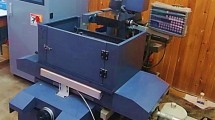Abstract
This study analyzes variations in metal removal rate (MRR) and quality performance of roughness average (R a) and corner deviation (CD) depending on parameters of wire electrical discharge machining (WEDM) process in relation to the cutting of pure tungsten profiles. A hybrid method including response surface methodology (RSM) and back-propagation neural network (BPNN) integrated simulated annealing algorithm (SAA) were proposed to determine an optimal parameter setting. The results of 18 experimental runs via a Taguchi orthogonal table were utilized to train the BPNN to predict the MRR, R a, and CD properties. Simultaneously, RSM and SAA approaches were individually applied to search for an optimal setting. In addition, analysis of variance was implemented to identify significant factors for the processing parameters. Furthermore, the field-emission scanning electron microscope images show that a lot of built-edge layers were presented on the finishing surface after the WEDM process. Finally, the optimized result of BPNN with integrated SAA was compared with that obtained by an RSM approach. Comparisons of the results of the algorithms and confirmation experiments show that both RSM and BPNN/SAA methods are effective tools for the optimization of parameters in WEDM process.
Similar content being viewed by others
References
Sarkar S, Sekh M, Mitra S, Bhattacharyya B (2008) Modeling and optimization of wire electrical discharge machining of γ-TiAl in trim cutting operation. J Mater Process Technol 205(1–3):376–387
Bamberg E, Rakwal D (2008) Experimental investigation of wire electrical discharge machining of gallium-doped germanium. J Mater Process Technol 197(1–3):419–427
Rakwal D, Bamberg E (2009) Slicing, cleaning and kerf analysis of germanium wafers machined by wire electrical discharge machining. Mater Manuf Process 209(8):3740–3751
Garg RK, Singh KK, Sachdeva A, Sharma VS, Ojha K, Singh S (2010) Review of research work in sinking EDM and WEDM on metal matrix composite materials. Int J Adv Manuf Technol 50(5–8):611–624
Mahapatra SS, Patnaik A (2007) Optimization of wire electrical discharge machining (WEDM) process parameters using Taguchi method. Int J Adv Manuf Technol 34(9–10):911–925
Prasad DVSSSV, Gopala Krishna A (2009) Empirical modeling and optimization of wire electrical discharge machining. Int J Adv Manuf Technol 43(9–10):914–925
Rao RV, Pawar PJ (2009) Modelling and optimization of process parameters of wire electrical discharge machining. Proc IME B J Eng Manuf 223(11):1431–1440
Gauri SK, Chakraborty S (2010) A study on the performance of some multi-response optimisation methods for WEDM processes. Int J Adv Manuf Technol 49(1–4):155–166
Sanchez JA, Rodil JL, Herrero A, Lacalle LNL, Lamikiz A (2007) On the influence of cutting speed limitation on the accuracy of wire-EDM corner-cutting. J Mater Process Technol 182(1–3):574–579
Han F, Zhang J, Soichiro I (2007) Corner error simulation of rough cutting in wire EDM. Preci Eng 31(4):331–336
Dodun O, Gonçalves-Coelho AM, Slătineanu L, Nagîţ G (2009) Using wire electrical discharge machining for improved corner cutting accuracy of thin parts. Int J Adv Manuf Technol 41(9–10):858–864
Yang YK, Chang TC (2006) Experimental analysis and optimization of a photo resist coating process for photolithography in wafer fabrication. Microelectronics J 37(8):746–751
Yang YK, Shie JR, Liao HT, Wen JL, Yang RT (2008) A study of Taguchi and design of experiments method in injection molding process for polypropylene components. J Reinf Plast Comp 27(8):819–834
Kurt M, Bagci E, Kaynak Y (2009) Application of Taguchi methods in the optimization of cutting parameters for surface finish and hole diameter accuracy in dry drilling processes. Int J Adv Manuf Technol 40(5–6):458–469
Badkar DS, Pandey KS, Buvanashekaran G (2011) Parameter optimization of laser transformation hardening by using Taguchi method and utility concept. Int J Adv Manuf Technol 52(9–12):1067–1077
Sushil K, Satsangi PS, Prajapati DR (2010) Optimization of green sand casting process parameters of a foundry by using Taguchi’s method. Int J Adv Manuf Technol 55:23–34. doi:10.1007/s00170-010-3029-0
Tzeng CJ, Yang YK (2008) Determination of optimal parameters for SKD11 CNC turning process. Mater Manuf Process 23(4):363–368
Liu NM, Chiang KT, Horng JT, Chen CC (2010) Modeling and analysis of the edge disintegration in the EDM drilling cobalt-bonded tungsten carbide. Int J Adv Manuf Technol 51(5–8):587–598
Chuang MT, Yang YK, Hsiao YH (2009) Modeling and optimization of injection molding process parameters for thin-shell plastic parts. Polymer Plast Tech Eng 48(7):745–753
Gaitonde VN, Karnik SR, Paulo Davim J (2009) Some studies in metal matrix composites machining using response surface methodology. J Reinf Plast Compos 28(20):2445–2457
Karunakar DB, Datta GL (2008) Prevention of defects in castings using back propagation neural networks. Int J Adv Manuf Technol 39(11–12):1111–1124
Vafaeesefat A (2009) Optimum creep feed grinding process conditions for Rene 80 super alloy using neural network. Int J Precis Eng Manuf 10(3):5–11
Öktem H (2009) An integrated study of surface roughness for modelling and optimization of cutting parameters during end milling operation. Int J Adv Manuf Technol 43(9–41):852–861
Zemin F, Jianhua M (2011) Back prediction of high-strength sheet metal under air bending forming and tool design based on GA–BPNN. Int J Adv Manuf Technol 53(5–8):473–483
Qiao H (2006) A systematic computer-aided approach to cooling system optimal design in plastic injection molding. Int J Mech Sci 48(4):430–439
Arul S, Samuel Raj D, Vijayaraghavan L, Malhotra SK, Krishnamurthy R (2006) Modeling and optimization of process parameters for defect toleranced drilling of GFRP composites. Mater Manuf Process 21(4):357–365
Sayarshad HR, Ghoseiri K (2009) A simulated annealing approach for the multi-periodic rail-car fleet sizing problem. Comput Oper Res 36(6):1789–1799
Yang SH, Srinivas J, Mohan S, Lee DM, Balaji S (2009) Optimization of electric discharge machining using simulated annealing. J Mater Process Technol 209(9):4471–4475
Chen HC, Lin JC, Yang YK, Tsai CH (2010) Optimization of wire electrical discharge machining for pure tungsten using a neural network integrated simulated annealing approach. Exp Syst Appl 37(10):7147–7153
PLANSEE high performance materials. www.plansee.com/
Montgomery DC (2005) Design and analysis of experiment, 6th edn. Wiley, New York
Author information
Authors and Affiliations
Corresponding author
Rights and permissions
About this article
Cite this article
Yang, R.T., Tzeng, C.J., Yang, Y.K. et al. Optimization of wire electrical discharge machining process parameters for cutting tungsten. Int J Adv Manuf Technol 60, 135–147 (2012). https://doi.org/10.1007/s00170-011-3576-z
Received:
Accepted:
Published:
Issue Date:
DOI: https://doi.org/10.1007/s00170-011-3576-z




